Food and Drink: Did You Know?
Street Food SceneIndia’s vibrant street food culture is a key aspect of its culinary landscape. Each region offers its own specialties, such as chaat (a family of savory snacks) and vada pav (a deep fried potato dumpling placed inside a bread bun). Another favorite is pani puri, small and hollow deep-fried dough balls filled with a combination of finely diced potato, onion, peas, and chickpea. Grilled chicken skewers and the fried-and-filled pastries, samosas, are other popular options. ▶ |
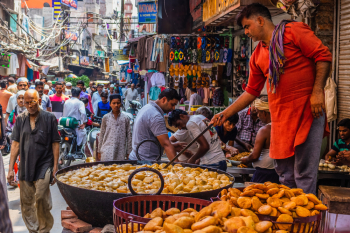 |
Spices GaloreIndia is known as the "Land of Spices" and is one of the largest producers and exporters of spices globally, including black pepper, cardamom, and turmeric. These spices, along with cinnamon, have been used by Indians for thousands of years for both culinary and health purposes. Cardamom and turmeric, spices indigenous to India, were cultivated as early as the eighth century BCE in the gardens of Babylon. ▶ |
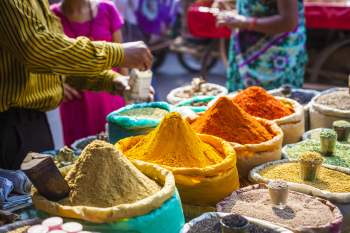 |
No Meat, PleaseIndia has the highest number of vegetarians in the world, with over one-third of the population identifying as vegetarians. This is influenced by religious and cultural practices, particularly within religions, Hinduism and Jainism. ▶ |
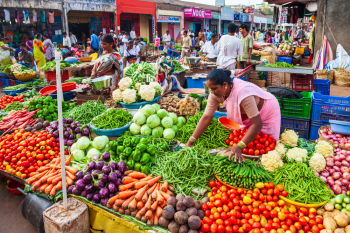 |
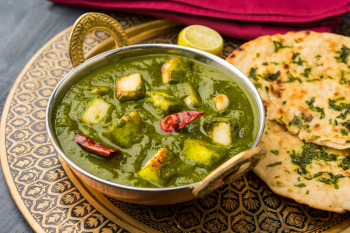 |
Regional Differences◀ Northern Indian cuisine uses more milk products than that of southern India. It’s also less spicy than southern cuisine. The north also is known for its tandoori chicken and butter chicken, while the south is known for its dosas and idlis. However, despite the differences, a traditional Indian meal typically consists of a variety of dishes, including rice, dal (lentils), vegetables, and meat or chicken. |
Introduced IngredientsPotatoes, tomatoes, and chilies didn’t originate in Indian cuisine, as Portuguese traders introduced the ingredients to the country in the 15th and 16th centuries. Saffron was likely brought to India by Greek or Roman traders. Naan bread, which is traditionally associated with Indian cuisine, most likely originated in Persia, in the 1300s. ▶ |
 |
Tops In TeaIndia is a major tea producer, with regions like Assam, Darjeeling, and Nilgiri known for their distinctive varieties of tea. India is the second-largest producer of tea in the world after China, producing nearly 25 percent of the world's tea. ▶ |
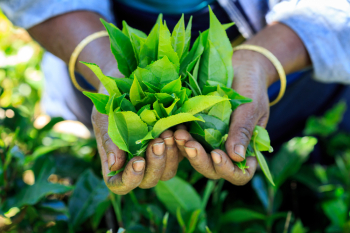 |
Ancient InfluenceIndian cuisine is heavily influenced by ayurveda, the ancient system of medicine that emphasizes balance and the healing properties of food. Among ingredients used for ayurvedic purposes are ginger, fennel, turmeric, aloe vera, cardamom, basil, and cinnamon. ▶ |
 |
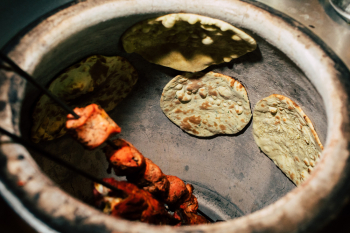 |
Traditions Remain◀ The tandoor, a traditional clay oven, is widely used in India for cooking a variety of dishes, including naan bread and tandoori chicken. Tandoori cooking can be traced back more than 5,000 years, to the banks of the Indus River where the first tandoor ovens were crafted from clay. |
Staple GrainsRice and wheat are the most commonly consumed grains in India. The staple foods vary by region, with rice being predominant in the south and east, and wheat—often in the form of roti or chapati bread—in the north and west. ▶ |
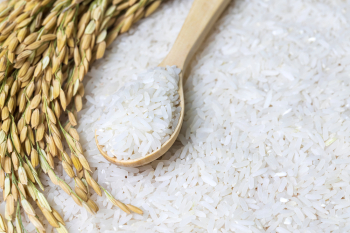 |
Pickling PracticePickling is a common practice in India, with a large variety of pickles made from fruits, vegetables, and even meats, preserved with spices and oil. Cucumbers native to India were first pickled in 2030 BCE in the Tigris Valley. ▶ |
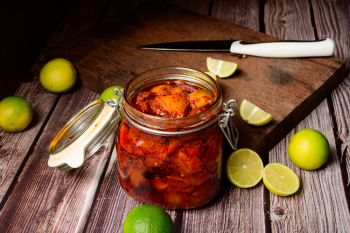 |
Among the OldestSome of the oldest cookbooks were written in India. The Nimatnama, which means "book of delights" was written in the 15th century and contains recipes for a variety of dishes, including biryani, kebabs, and curries. ▶ |
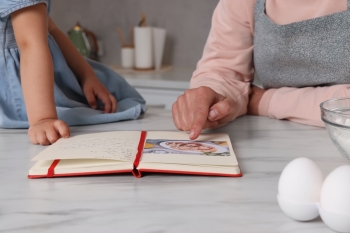 |
 |
Finger Food◀ In many parts of India, it is traditional to eat with the right hand, using fingers to mix and scoop food. Indians believe that eating is a sensory experience that includes touch in addition to a meal's taste and aroma. |
GheeGhee is clarified butter with no milk elements left in it, and has been used in India for thousands of years. Ghee is widely used in South Indian cuisine, including rice dishes, sweets, and for tempering curries. ▶ |
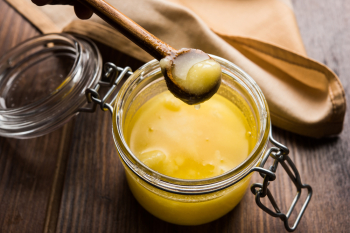 |
Spice BoxMany Indian kitchens have a masala dabba, a round spice box containing essential spices used in everyday cooking. Typical spices include turmeric, cumin seed, cardamom, coriander seed, chili powder, black mustard seeds, and garam masala. Garam masala is a spice mix that can vary in ingredients but typically consists of ground spices such as cloves, cinnamon, cardamoms, cumin, coriander, nutmeg, bay leaf, mace, and black pepper. ▶ |
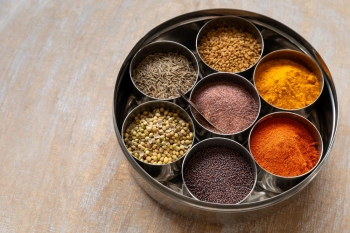 |
Currying FlavorCurry is a thick sauce, cooked with vegetables and meat and served with rice or bread. It can also be the name for a dish, with Indian known for its many curries. Chicken tikka masala, butter chicken, pork vindaloo, and chicken korma are just a few popular curries. ▶ |
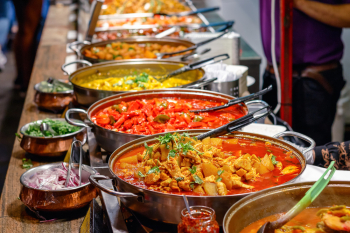 |
Copyright © 1993—2025 World Trade Press. All rights reserved.

 India
India